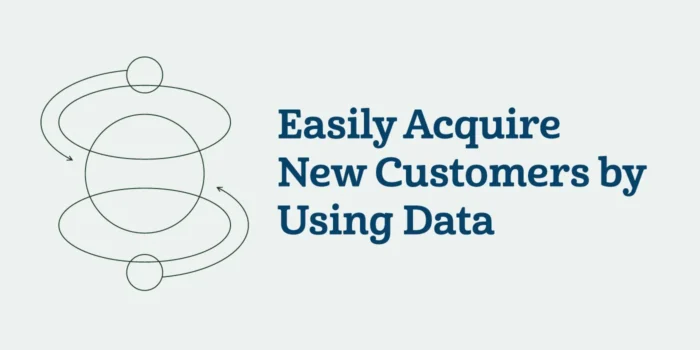
It’s no shock that attracting new customers is a primary business goal for most companies around the globe, but with an oversaturated market and increasing digital involvement, it is also no surprise that this is a difficult task. It can be five times more expensive to gain a new customer than it is to retain an existing one. Overcoming that challenge offers a significant reward, though. Research shows that increasing customer retention rates by just 5% can increase profits anywhere from 25% to a whopping 95%.
So how do you increase your client acquisition without spending thousands per customer? Data. It plays a role in almost every approach to acquisition marketing and can help you obtain new customers.

What Is a Customer Acquisition Strategy, and Why Does It Matter?
A customer acquisition strategy is a company’s approach to bringing in new customers. It involves marketing efforts, advertising, referral programs and sales, among other methods used to draw someone in. You may need to persuade them to use your service or convince them of the benefits of a product. Perhaps you need to add value with a customer loyalty program. All of these are ways a company may try to acquire new customers.
Customer acquisition is essential to judging the value each customer brings to a business. A significant component of a client acquisition strategy is the customer acquisition cost (CAC). The CAC is a calculation of the amount of money required to bring in a new client or customer, and it can vary widely among industries. Minimizing CAC can help save money and ensure that you still get a profitable return on investment from the customers you acquire. We’ll talk about it in more detail later, but this number is a significant component of your strategy.
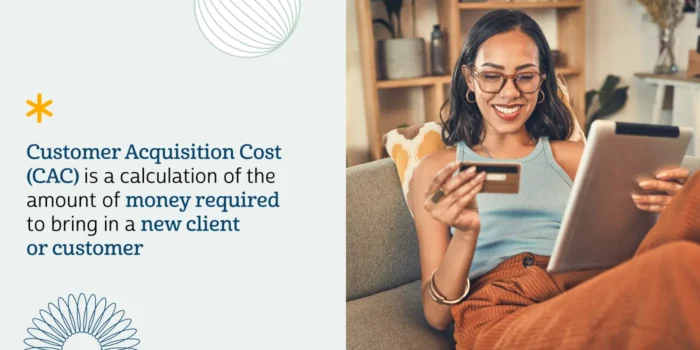
For smaller businesses or those just starting, a customer acquisition strategy may be more crucial than it is for larger, established businesses. It can help them grow and develop personalized relationships with many of their clients. Businesses of all sizes still need to focus on acquisition, as it is a major player in a company’s continued sales and success.
Who’s Involved in Customer Acquisition?
Acquiring new customers is a joint effort that requires collaboration and data. Customer acquisition cost is an investment, but with the right insights and team, it can pay off in dividends. These are the parts of an organization that play crucial roles in how you acquire new customers:
- Marketing department: Those in marketing use data to reach out and communicate with leads and customers. This helps customer acquisition by converting casual followers and leads into loyal customers. Using data helps marketing teams identify the best customer acquisition channels, create strategies and execute campaigns that resonate with the intended audience.
- Creative teams: Using data and insights, the creatives in your team will find the best ways to present content and your company’s offerings to existing customers and prospects. The more they know about your audience, the better their content will be at grabbing attention and inciting action.
- Sales representatives: Sales reps find leads that are generated by the work of the marketing and creative teams. They emphasize the benefits of the offerings and the brand’s best qualities to convince leads to take action and commit.
Why Is Data Central to Your Customer Acquisition Strategy?
Much of customer acquisition is about identifying patterns and trends in behavior, particularly those that indicate a substantial likelihood of a person converting to your business. Data helps us understand those patterns and trends. Understanding your existing customers can help you understand potential customers, and appealing to your potential customers with the data they provide, such as previous purchases and search queries, can better your chances of conversion or acquisition. You can personalize your paid advertising and market directly to the customer in the ideal acquisition channel, providing a competitive edge.
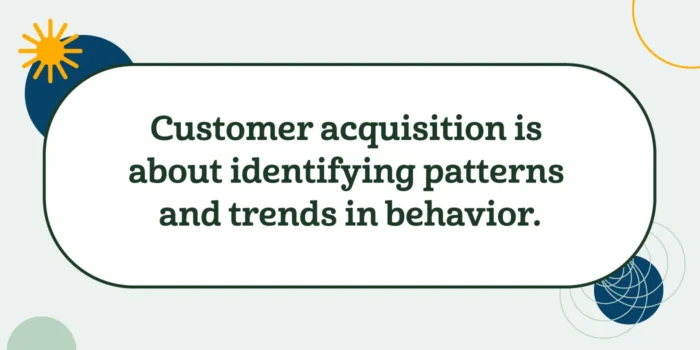
A critical aspect of using data to drive acquisition is that of cohesion. Departments must work together and have the same goal in mind. Otherwise, they may gather data improperly or misuse it. Duplicate records and inaccurate information can make analytics useless, while departments that don’t communicate with each other may not share the data, leading to inefficiency and hiding valuable connections. Keeping data streamlined and accurate is vital to a successful customer acquisition strategy.
Some of the methods businesses use in new customer acquisition marketing include:
- Improving SEO: This makes your website more visible to the people you want to target. SEO is a vital digital marketing tactic to stay competitive in today’s online market.
- Adding value: Using data properly allows you to develop new ways of delivering value all along the customer journey.. With the right data, you can perfect your sales pitches, rewards programs, free samples, etc..
- Using social media: The better you understand your audience, the better your social media marketing will do. Reaching people means standing out and proving you can deliver meaningful content and offerings that enhance their lives.
- Streamlining the conversion process: The more you cater your conversion process to your customers, the better it is at making it easy to acquire customers. Consider the entire customer acquisition funnel and all the steps you can optimize for conversions.
- Targeted email marketing: Speak directly to customers and leads with messages that grab their attention. Personalized email marketing builds strong consumer-brand relationships, inspires people to take action and promotes your brand and offerings. You can leverage dynamic triggers through marketing automation based on all of the data you have about your existing and prospective customers.
- Promoting referrals: Referral programs are the key to optimizing word-of-mouth marketing. Incentivizing referral programs helps you and your loyal customers to get the most out of it.
Nearly all these methods depend on data or can use it to improve their marketing efforts.
9 Data-Driven Strategies Proven to Drive New Clients
With new technologies and the ease of gathering data, customer acquisition has taken on a new dimension. It can be expensive to obtain a new client, and data offers unparalleled efficiency. You can easily collect information and send marketing materials directly to the customers they would affect most. Here are a few methods for improving your customer acquisition strategy that reap the benefits of data.
1. Nail Your Current Customer Acquisition Metrics
CAC is a vital measurement that helps you calculate the success of your customer acquisition plan. Finding the right CAC can save time and money and allow staff to improve the quality of the leads they generate. Some of the costs a CAC might include are:
- Personnel resources to execute and create content
- Ad spending
- Technical and publishing costs
- Other marketing expenses and overhead costs
To calculate the CAC, you’ll need to select a date range. Say you’ve chosen to review Q1. You would add together all the costs associated with acquiring the customer and divide the total by the number of new customers you got during Q1. The result is your CAC for that period.
Another number that you’ll want to find is the customer lifetime value (CLTV or LTV) of your conversions. Each customer provides an LTV of how much profit they will generate for the company, and this LTV should be higher than the cost it takes to acquire the customer in the first place. To get the LTV, find the average amount spent on a purchase and the frequency of purchases throughout that time. Multiply these values together to find the customer value. Finally, multiply that result by the average number of years a customer purchases items from your business to find your LTV. This number provides you with an expectation of how much profit new customers are likely to generate.

Once you’ve found your CAC and LTV, compare the two. Most marketers suggest a three-to-one LTV:CAC ratio. Reaching this ratio can help ensure the profitability of your acquisition efforts. It confirms that your marketing effort isn’t returning low-benefit customers or none at all. These numbers offer you a comprehensive view of the viability of customer acquisition efforts.
2. Offer Multiple Marketing Channel Communication
In the digital age, customers need to be able to contact a company when and how they want, and it may correlate to reaching business goals. Leaders in customer experience are nearly three times as likely as their colleagues to exceed their top business goals significantly, and contact is a part of that.
Between social media channels, email, website contact forms and phone numbers, people have different preferences across demographics and industries. Reaching customers through their preferred medium and in the right way can be a significant part of interacting with them and creating a positive experience.

Consider how customers can reach out to you if they have a problem. Are you easy to get in touch with, and can they reach you in a variety of ways? What do they do if they need to make a payment? You can make it easier on your customers by providing multiple payment options, such as paying:
- Online
- Over the phone
- By mail
Unsure of how to find out what your customers want? Send a survey. Ask them questions like how they prefer you contact them and how they would like to contact you or make payments. Finding their preferred channels can help you improve targeted communications and satisfaction.
You’ll need to understand your audience and their needs to select the appropriate channels. For example, advertising on Snapchat and Instagram won’t do you much good if your audience is mostly older people who don’t use smartphones in the first place. Surveying them and using the data you gather can help you inform your channels of communication.
3. Discover Lookalike Audiences
Lookalike modeling creates a profile of your target audience and identifies people who look and act in similar ways. By analyzing key characteristics, you can find new audiences that closely match your target audience to scale marketing campaigns and increase ROI. Essentially, lookalike audiences are an expansion of the customers you already have.
It probably took a lot of work to find the ideal customer, so it makes sense that you would want to identify more like them.
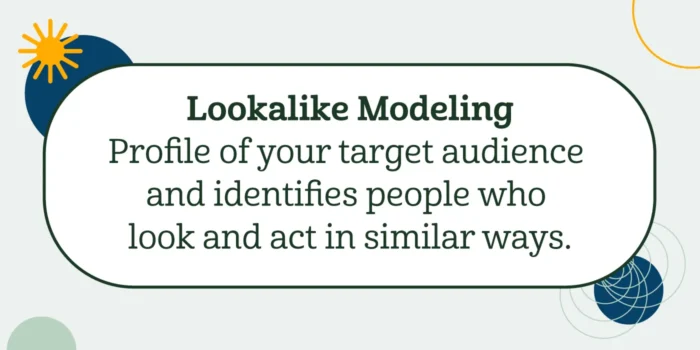
The process of developing a lookalike audience starts with a small pixel placed onto a page, such as a purchase confirmation page. This pixel is a small piece of code that can collect customer data about their web use. Some characteristics it may pull include:
- Location
- Demographics
- Purchase history
- Search history
You’ll need to include data from multiple channels when creating this audience. For instance, if your biggest purchasers buy over the phone and you’re only calculating data from digital purchases, you may be missing out on a significant chunk of information. Be sure to collect as many sources as possible when compiling your data.
When you have your lookalike audience, you can target more effectively and bring in more customers you know tend to behave in the same ways as your current ones.
A lookalike audience is never complete. Leaving the program to run and gather more data can help it learn more about your current audience and adapt as needed.
4. Understand Signals of Intent
Signals of intent are the context clues and data that tell us what a potential customer is doing. A signal of intent to buy a pair of shoes, for example, might be someone doing a Google search for shoes in their size. Other factors that can contribute to signals of intent include the activity around the search. If they’ve already been searching for shoes for a while, they may be closer to making a purchase. If they’re searching from a mobile device while in a shoe store, they could be looking for a cheaper option or to see if their size is available online.
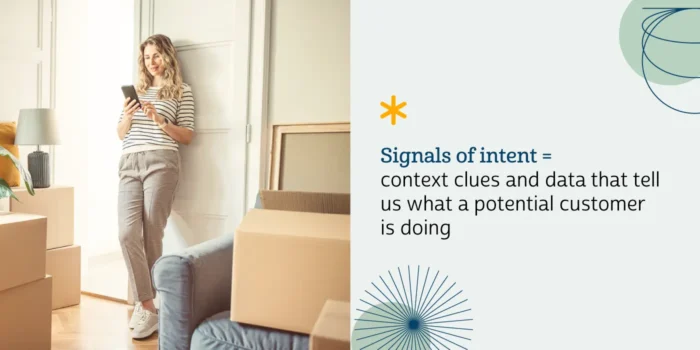
What the person does next is also a valuable signifier for their intent. If they purchase directly after finding a listing on a website without any previous searches, we know that they may not be the most thorough of shoppers. If this was the start of a long search, we see the opposite is true, and they may be more methodical in their searching. These approaches can tell us more about the individual’s shopping habits.
One of the primary signals of intent is signal keywords. These keywords are part of why companies perform search engine optimization. The goal is to reach customers who already show interest in the item for sale. Core keywords address the topic itself, while adjacent keywords are closely related. Other keyword designations include:
- Early-stage words: Indicate the buyer’s interest in a topic, such as “how to,” “why” and “what is”
- Mid-stage words: Show the evaluation of solutions, like “best” and “examples”
- Late-stage words: Indicate the buyer is close to purchasing and is choosing between options using words like “price,” “vs” and specific brand names
Signals of intent can also relate to current events. If a change in legislation or a new industry development occurs, you can capitalize on that and create outreach to target the customers likely to experience the effects. If you know someone will be looking for information about the issue, sending an email to the right people about the topic can help get you out in front.
5. Run Retargeting Campaigns
Retargeting or remarketing ads help you reconnect with previous customers and leads. This effective customer acquisition strategy focuses on getting people who interacted with your brand in the past to convert. A major advantage to using this marketing strategy is targeting people you know are interested in your brand. By using data you have on them, you can identify where they changed their mind in the process and focus on getting them past that stage.
Retargeting involves leads who clicked on links in emails, abandoned their carts or visited your website. The goal is to re-spark their interest and compel them to act. This could be by advertising new content, features or a sale. You can always use reminder advertising to subtly get their attention, like social media ads or emails. The data you gather on your customers through website cookies is especially helpful in retargeting ads.
Increasing customer acquisitions using retargeting ads requires some tact. You must be careful not to overwhelm customers with ads. This can harm consumer-brand relationships and make them actively avoid your brand. Remind and entice your leads, but avoid bombarding them.
6. Deliver Personalized Customer Experiences
With the growth of data and analytics, it is easier than ever before to provide people with a customized shopping experience. People expect targeted ads, emails, product suggestions and more from companies they’ve already worked with, but you can also use personalization to acquire new customers.
Using data can help you offer behavior-based recommendations that give the customer a personal experience and can increase the chances of them becoming a customer or client. Adobe found that almost a quarter of larger organizations think data-driven marketing that focuses on the individual is the single most exciting opportunity for their organizations. These targeted recommendations align with their purchasing patterns and may consider similar audience actions.
For example, if your customer frequently watches video content more often than they read blog posts, you can pull that data from the data management platform with a tool that will suggest more video content for them. Or, if you know a shopper likes handbags, you can suggest these as a recommended product instead of something they’re not interested in.
This kind of personalization can also come into play with the types of goals you are looking to accomplish.
7. Create Referral Programs
Learning how to acquire new customers effectively with a referral program is invaluable. A referral program incentivizes your customers to recommend your brand and offerings. Using customer data, you can target your most loyal and active customers. Send them referral program invitations to reward them for their loyalty and encourage them to find more leads. It’s best to send invitations to customers you know will be interested in helping and earning rewards.
Referral programs are a powerful tool because word-of-mouth advertising is highly effective. Using your customer data, you can learn more about what incentives to provide in your program and set reasonable goals for them. These programs are an excellent idea for new customer acquisition campaigns. This strategy for customer acquisition costs very little to implement and yields significant results. If you want to increase word-of-mouth marketing, then a referral program is your best option.
8. Use Search Engine Optimization
Search engine optimization (SEO) is the process of optimizing your website’s ranking on search engines to increase organic traffic. This requires keyword research and using your customer data to understand the topics they are most interested in. The insights you gain from keyword research and customer data will help guide your content and improve your website’s ranking.
Making full use of on-page and off-page SEO strategies can significantly boost your website’s visibility on search engines. On-page SEO is when you optimize elements on your website. This includes meta tags, keywords, URLs and new or refreshed content. Off-page SEO means taking action outside your website, like including authoritative links and working on your backlinking.
SEO is a continuous effort that needs to be worked on thoroughly and regularly to yield its full potential. You need to stay updated on the best keywords to target and track your website’s ranking in search engine algorithms. It also requires you to constantly keep up to date on user behavior to create relevant and meaningful content.
9. Implement Predictive Analytics
Predictive analytics is when data is used to identify future probabilities. This process uses historical data, current data, machine learning and statistical algorithms to make reasonable predictions based on reliable data. Using data for predictive analytics is a highly effective way of planning future content and campaigns and keeping one step ahead of competitors. In terms of customer acquisition, it helps you anticipate the needs and behavior of leads and communicate with them accordingly.
Using predictive analytics can help you gain a deeper understanding of your audience and their behavior. It’s a vital part of anticipating what your customers will do next and finding new ways to convert them. While the insights generated from predictive analytics are valuable, they are not guaranteed. It’s important to have some wiggle room and plan actions that do not solely rely on future probabilities.
Frequently Asked Questions
How can you target the right audience for new customer acquisition?
What are the key challenges in new customer acquisition?
Using Data for Customer Acquisition
Lotame’s data collaboration solutions can improve your customer acquisition strategy and help you balance your CAC and LTVs. Whether you want to develop personalized customer experiences or find new audiences across multiple channels, Lotame can help.
We can assist in collecting, organizing, activating and enriching data segments to use with targeted advertising and personalized content for your user acquisition strategy. Acquisition marketing relies heavily on client data, and we have access to second- and third-party data segments, meaning we can get you more information that helps you learn about your audience and potential clients.
When you need to improve your custom acquisition strategy, contact the experts at Lotame for more information.